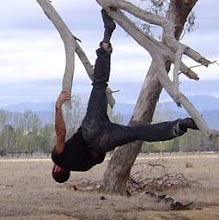
In the meantime our winter seeds are rocking. Heirloom elephant leek, garlic, silverbeet fordhook, pak choy, sweet pea, broad beans, broccoli, carrots, black kale, spinach, spring onions, beetroot, baby cos lettuce and cabbage mini. Meg and I were discussing today how many families could potentially be living on this quarter acre in 10-20 years. I think it could feed about 15-18 people in the Summer months and maybe 10-12 in Winter.

I'm looking down on young banksias and heavily mulched areas with lomandras, poa tussocks, broad beans, almonds, olives, peaches and my chain-sawed eucalyptus balls. The dry stone HaHa wall back-filled with rubble allows for water to pass through it without disturbing the integrity of the wall. You can also see a little of the social warming fence. We persuaded our neighbours not to have a fence that lined the whole boundary, but just enough to have a little more privacy. They also agreed that I could build it as a slatted fence, again for social warming properties. Of course the water tank finishes the picture and finishes an often quoted mantra on this blog spoken by Cuban permaculturalist Roberto Perez at our town hall last year–
Grow your own food, catch your own water, say hello to your neighbour.

Here's a pic of the main house showing flying fox route and solar panels. I'm also showing off my deck building skills here. Split level decks are party decks. You often hear of them collapsing and killing a dozen stomping teenagers, that's why this one is low to the ground.

I love Zeph's cubby as much as he does. Apart from the obvious – cute, small, red, up-in-the-air – it frost protects our toms. Meg collected another basket full last week. Almost unbelievably the fruit was still ripening despite the plants having died weeks ago. They're not great, but fine for cooking up. You can also see the beginning of the flying fox route and the tail end of the social warming fence. The bed in front of it will be the kick-arse rhubarb patch. Rhubarb is year-round gold for food gardeners. I remember my Dad's awesome patch when I was Zeph's age.

And, finally a place very dear to my heart – the compost area. Underneath the new window of the Shed of Interrelation is a herb bed that's doing OK, but I have decided to dig them out and extend the compost bays to three. We'll also have the humanure from the dry worm composting toilet. Therefore we can have four brews at four different stages. I'm so excited about this. The building of the Shed of Interrelation has already led to so many possibilities, even before the first resident.



















